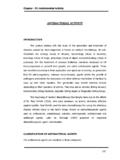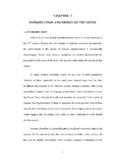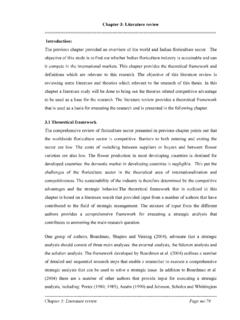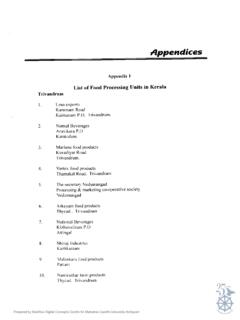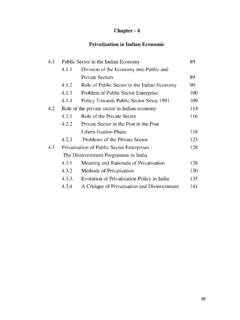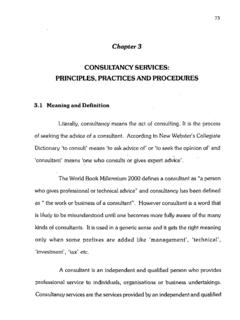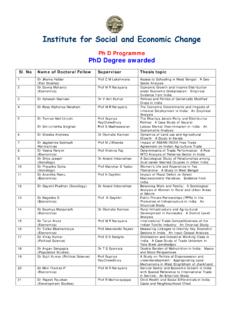Transcription of REVIEW OF LITERATURE - Shodhganga
1 Chapter IV. REVIEW OF LITERATURE . This chapter is an elucidation of LITERATURE relating to the flow of credit from various organised and unorganised sources of housing and real estate finance. The aim of such a perusal is to have a bird's eye view of the concurrent and corresponding issues and problems related to the present study. The first part deals with the flow of credit from organised institutions to various sectors like manufacturing industry, private corporate sector and various other industrial concerns. Studies on the institutional flow of credit in Kerala are also discussed.
2 The unorganised sector consisting of indigenous financial agencies is enumerated in the next part. Understanding the operation of and the potential for housing finance is important, since in many developing countries 'housing'. policy is about establishing new and more innovative finance policies. The banking system in India comprises of the Reserve Bank of India, Commercial banks and cooperative banks and credit societies. The commercial banks are the premier institutional structure of the 104. banking system. The principal function of these institutions is to satisfy simultaneously the portfolio preferences of the borrowers on one side and the lenders on the other.
3 They mobilise resources from the savers in the form of deposits and extend credit facilities to borrowers in the form of loans, advances and securities. Loans and advances provided by these institutions can be categorised into short-term funds and long-term funds. The latter are advanced for purchase of plant and machinery while the former are provided for purchase of raw materials, stores, spare parts and the like. However following the traditional British banking practice, commercial banks provide more short term funds to the investors in industry and trade than long term loans.
4 The pattern of credit disbursement has undergone substantial changes since 1950. Commercial banks extended credit to commerce and trade to a larger extend than to manufacturing industry until 1958. Since the commencement of the second five Year Plan, which laid emphasis on rapid industrialisation, the pattern of credit flow took a new turn in favour of medium and large industry. As a result, the share of industry, in public and private sectors in total bank credit increased from to during the period 1954 to 1968. Since nationalisation of 14 major commercial banks in July 1969, the Government of India assigned new priorities to commercial banks with regard to the flow of credit to hitherto neglected sectors, called 105.
5 "priority sectors." The emphasis thus shifted from industry to the priority sectors. Further the supply of credit was controlled through statutory regulations and monetary regulations. On the other hand the demand for bank credit has also undergone substantial increase. Factors such as, large growth in the number of industrial units, diversification of existing units, increase in industrial and agricultural production, increasing needs of short and long-term funds to maintain the increased levels of production, pushed up the demand for bank credit. ~ u ~ t and a ' ~ m b e ~ e o k aobserved r* that the use of funds from banks by the private corporate sector had exceeded its inventory formation.
6 Gupta, has argued that a small portion of such finance should have gone to meet fixed investment. Further, he found the growth rate of physical assets to be more directly and closely related to security issues than bank credit. Hence, he argued that the fast growing firms relied heavily on security issues than the use of bank credit. Arnbegeokar found that the rate of rise in bank credit exceeded that of inventory, sales and output. Further he observed 1. L . S . Gupta (1969). Changing Structure of Industrial Finance in India, The Impoct oj'lnstitutional Finance, Clarendon Press: Oxford.
7 2. N. Ambegaokar (1969). " working capital Requirement and Availability o f Bank Credit: Indian Processing and Manufacturing Industries," Reserve Bank of India Bulletin Vol XXIII. No:lO. 106. that its dependence on banks for working capital had increased, accompanied by a decline in reliance on other financial institutions. shetty3 assessed the dimensional changes in credit deployment during the first five years of nationalisation in relation to changes in output and prices. The rationale for his analysis was the fact that, in any accepted model of demand for money, one common variable is the gross national product or some other variant of it in real terms.
8 Consequently, he hypothesised that credit for any sector or industry over a period has to have some relationship with its performance in real terms, particularly output. He observed a declining trend in the credit extended by banks to industries since nationalisation, though it was higher than other sectors. On finding that the share of manufacturing sector in bank credit is higher than its share in Net Domestic Product (NDP) he concludes that increase in bank credit has occurred far in excess of increase in output during the years 1968169 to 1973174. In his other paper, shetty4 observed that the share of medium and large industry in total bank credit had declined due to priority S.
9 L . Shetty (1976). "Deployment of Commercial Bank and other lnstitutio~lalCredit: A note on Structure changes." Economic and Political Weekly, Vol XI No: 1'1, M a y 8th . pp. 696-705. S L Shetty (1978). "Performance of Con~mercial Banks since o n Major Banks: Promises and Realty." Economic and Political N a t ~ o n a l ~ s a t ~of Weekly, Vol. XI1 No. 31, 32 & 34, August, pp. 1407-1451. sector lending. Another observation in line with his earlier finding was that growth in bank credit had always been disproportionate to growth of their physical output, especially in industries like cotton textiles.
10 His observation particularly for the years 1975-76 and 1976-77 revealed: (a) Increase in average bank credit had been higher than the growth of NDP originating in registered manufacturing sector even at current prices (b) An appreciable increase in the rate of short-term bank credit to inventories; and (c) Relatively higher reliance on trade credit. In line with these observations, he suggested policies to scrutinise credit claims vigorously and relate credit to the genuine production requirements so that funds are not tied up with these large borrowers. ~ a o 'carried out an econometric exercise on the determinants of demand for bank credit of some selected industries for the period between 1970-71 and 1984-85.
